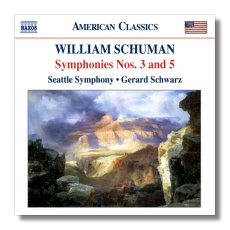
The Internet's Premier Classical Music Source
Related Links
- Schuman Reviews
- Latest Reviews
- More Reviews
-
By Composer
-
Collections
DVD & Blu-ray
Books
Concert Reviews
Articles/Interviews
Software
Audio
Search Amazon
Recommended Links
Site News
 CD Review
CD Review
William Schuman

- Symphony #3
- Symphony #5
- Judith – Choreographic Poem for Orchestra
Seattle Symphony Orchestra/Gerard Schwarz
Naxos 8.559317
Originally released on Delos, these recordings are part of a cycle of Schuman Symphonies appearing on Naxos that to date also includes discs pairing #4 and 9, and 7 and 10. In the past Schwarz has rightly received high praise for his efforts on behalf of a spate of largely neglected American composers, a group that includes David Diamond, Peter Mennin, Paul Creston, Walter Piston, Howard Hanson and Alan Hovhaness. Some will argue that Hanson, Hovhaness and perhaps Piston have not exactly been neglected; but let's face it, across the ocean even their popular works (Hanson's Second Symphony, "The Romantic", Hovhaness' Mysterious Mountain and God Created Great Whales, and Pistons' Incredible Flutist) have never really caught on. And most of their output on these shores is thoroughly neglected. It seems only Ives, Copland, Barber and Bernstein, among American composers, have gained a foothold in the repertory – and I'm not sure that Ives' popularity is all that widespread any more.
As for William Schuman – once a deservedly major figure on the American scene, regularly played and recorded by Koussevitzky and the Boston Symphony Orchestra, Ormandy and the Philadelphia Orchestra, Bernstein and the New York Philharmonic, as well as by other major American conductors and orchestras of generations past – he's largely forgotten today. Why? Part of the problem is that there are so many worthy composers – past and present – competing for elbow room in such a crowded field today. CDs containing music of lesser-knowns, or even unknowns, proliferate, thereby detracting from one another while trying to make their case. Some pianist or conductor is constantly laboring in hopes of reviving a forgotten composer from the past: Mozart contemporaries Josef Mysliveček and Joseph Martin Kraus, for example, or 20th-century figures like Charles Koechlin and Nikolaos Skalkottas, or any number of contemporary composers.
Schuman suffers the further misfortune of having a name that is constantly confused with the much better-known composer Robert Schumann, to the extent that for years his recordings often ended up in Robert Schumann's bins at the record stores. However William Schuman is evaluated, or whatever attention is paid to his music by posterity, this recording, and those in the series thus far, do him great justice.
The 1941 Third Symphony is cast in two movements, each in two parts, the whole work lasting nearly a half-hour. The first movement is marked Passacaglia and Fugue and the second, Chorale and Toccata. Though the work is based on Baroque models, its music is much a product of its time in its expressive character and orchestration. The symphony is colorful and brimming with energy, though both its movements begin seriously, solemnly even. The orchestral writing is assured and leaves one with little wonder that the piece was given the New York Music Critics' Circle Award in 1941.
The three-movement Fifth Symphony (1943), scored for strings only, is a slighter work, with a duration of eighteen minutes. It is a serious, mostly energetic piece exuding much contrapuntal activity and coming across ultimately with a sense of optimism, an optimism somewhat hard-earned in that the finale must shrug off the hypnotic effects of the dreamy, gloomy, but quite arresting middle movement.
The ballet Judith dates to 1949, when, at the behest of the Louisville Orchestra, renowned dancer and choreographer Martha Graham asked Schuman for a score for the scenario she devised for Judith, a bloody ancient story about the Hebrew woman who beheaded Holofernes, Assyrian general and lackey of Nebuchadnezzar, thus saving her people. The music is grim, as colorful though as the symphonies, and quite attractive in its building tension and danceable, jazz-tinged rhythms. The work makes a fine bonus, and to me, must share a place with the symphonies in artistic importance.
Gerard Schwarz and the Seattle players perform each work with commitment and energy. The sound – dating from 1991-92 – is clear and powerful. The notes by Steven Lowe are most informative. This is one of the more important releases in Naxos' splendid American Classics series. Highly recommended.
Copyright © 2007, Robert Cummings




















